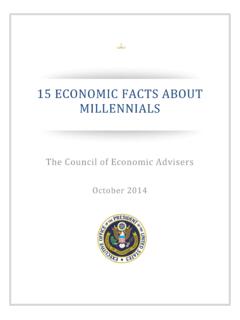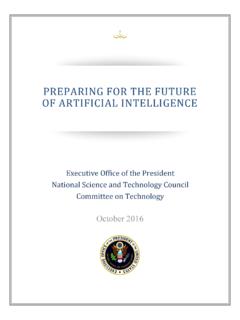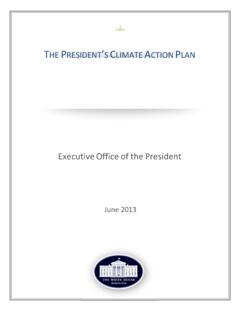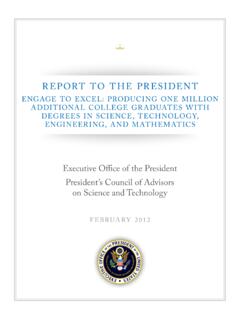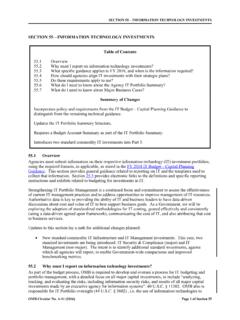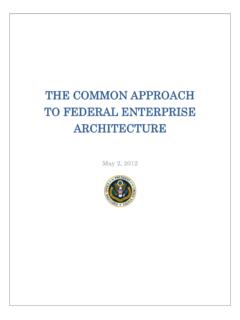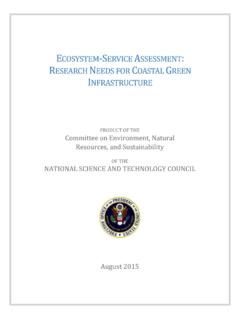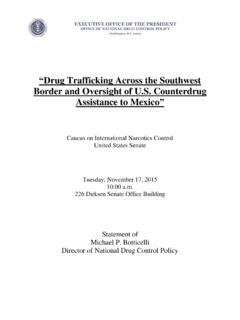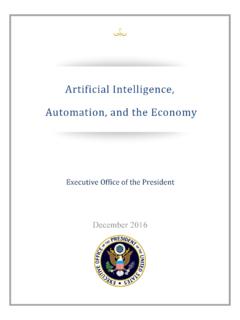Transcription of The National Artificial Intelligence ... - The White House
1 October 2016 THE National Artificial Intelligence RESEARCH AND DEVELOPMENT STRATEGIC PLAN National Science and Technology Council Networking and Information Technology Research and Development Subcommittee ii iii About the National Science and Technology Council The National Science and Technology Council (NSTC) is the principal means by which the Executive Branch coordinates science and technology policy across the diverse entities that make up the Federal research and development (R&D) enterprise. One of the NSTC s primary objectives is establishing clear National goals for Federal science and technology investments.
2 The NSTC prepares R&D packages aimed at accomplishing multiple National goals. The NSTC s work is organized under five committees: Environment, Natural Resources, and Sustainability; Homeland and National Security; Science, Technology, Engineering, and Mathematics (STEM) Education; Science; and Technology. Each of these committees oversees subcommittees and working groups that are focused on different aspects of science and technology. More information is available at About the Office of Science and Technology Policy The Office of Science and Technology Policy (OSTP) was established by the National Science and Technology Policy, Organization, and Priorities Act of 1976.
3 The mission of OSTP is threefold; first, to provide the President and his senior staff with accurate, relevant, and timely scientific and technical advice on all matters of consequence; second, to ensure that the policies of the Executive Branch are informed by sound science; and third, to ensure that the scientific and technical work of the Executive Branch is properly coordinated so as to provide the greatest benefit to society. The Director of OSTP also serves as Assistant to the President for Science and Technology and manages the NSTC. More information is available at About the Subcommittee on Networking and Information Technology Research and Development The Subcommittee on Networking and Information Technology Research and Development (NITRD) is a body under the Committee on Technology (CoT) of the National Science and Technology Council (NSTC).
4 The NITRD Subcommittee coordinates multiagency research and development programs to help assure continued leadership in networking and information technology, satisfy the needs of the Federal Government for advanced networking and information technology, and accelerate development and deployment of advanced networking and information technology. It also implements relevant provisions of the High-Performance Computing Act of 1991 ( 102-194), as amended by the Next Generation Internet Research Act of 1998 (P. L. 105-305), and the America Creating Opportunities to Meaningfully Promote Excellence in Technology, Education and Science (COMPETES) Act of 2007 ( 110-69).
5 For more information, see Acknowledgments This document was developed through the contributions of the members and staff of the NITRD Task Force on Artificial Intelligence . A special thanks and appreciation to additional contributors who helped write, edit, and review the document: Chaitan Baru (NSF), Eric Daimler (Presidential Innovation Fellow), Ronald Ferguson (DoD), Nancy Forbes (NITRD), Eric Harder (DHS), Erin Kenneally (DHS), Dai Kim (DoD), Tatiana Korelsky (NSF), David Kuehn (DOT), Terence Langendoen (NSF), Peter Lyster (NITRD), KC Morris (NIST), Hector Munoz-Avila (NSF), Thomas Rindflesch (NIH), Craig Schlenoff (NIST), Donald Sofge (NRL), and Sylvia Spengler (NSF).
6 Iv Copyright Information This is a work of the Government and is in the public domain. It may be freely distributed, copied, and translated; acknowledgment of publication by the Office of Science and Technology Policy is appreciated. Any translation should include a disclaimer that the accuracy of the translation is the responsibility of the translator and not OSTP. It is requested that a copy of any translation be sent to OSTP. This work is available for worldwide use and reuse and under the Creative Commons CC0 Universal license. vi vii National Science and Technology Council Chair John P. Holdren Assistant to the President for Science and Technology and Director, Office of Science and Technology PolicyStaff Afua Bruce Executive Director Office of Science and Technology Policy Subcommittee on Machine Learning and Artificial Intelligence Co-Chair Ed Felten Deputy Chief Technology Officer Office of Science and Technology Policy Co-Chair Michael Garris Senior Scientist National Institute of Standards and Technology Department of Commerce Subcommittee on Networking and Information Technology Research and Development Co-Chair Bryan Biegel Director.
7 National Coordination Office for Networking and Information Technology Research and Development Co-Chair James Kurose Assistant Director, Computer and Information Science and Engineering National Science Foundation Networking and Information Technology Research and Development Task Force on Artificial Intelligence Co-Chair Lynne Parker Division Director Information and Intelligent Systems National Science Foundation Co-Chair Jason Matheny Director Intelligence Advanced Research Projects Activity Members Milton Corn National Institutes of Health Nikunj Oza National Aeronautics and Space Administration William Ford National Institute of Justice Robinson Pino Department of Energy Michael Garris National Institute of Standards and Technology Gregory Shannon
8 Office of Science and Technology Policy Steven Knox National Security Agency Scott Tousley Department of Homeland Security viii John Launchbury Defense Advanced Research Projects Agency Faisal D Souza Technical Coordinator National Coordination Office for Networking and Information Technology Research and Development Richard Linderman Office of the Secretary of Defense National Artificial Intelligence RESEARCH AND DEVELOPMENT STRATEGIC PLAN 1 Contents About the National Science and Technology Council .. iii About the Office of Science and Technology Policy .. iii About the Subcommittee on Networking and Information Technology Research and Development.
9 Iii Acknowledgments .. iii Copyright Information ..iv National Science and Technology Council .. vii Subcommittee on Machine Learning and Artificial Intelligence .. vii Subcommittee on Networking and Information Technology Research and Development .. vii Task Force on Artificial Intelligence .. vii Executive Summary .. 3 Introduction .. 5 Purpose of the National AI R&D Strategic Plan .. 5 Desired Outcome .. 7 A Vision for Advancing our National Priorities with AI .. 8 Current State of 12 R&D Strategy .. 15 Strategy 1: Make Long-Term Investments in AI Research .. 16 Strategy 2: Develop Effective Methods for Human-AI Collaboration.
10 22 Strategy 3: Understand and Address the Ethical, Legal, and Societal Implications of AI .. 26 Strategy 4: Ensure the Safety and Security of AI Systems .. 27 Strategy 5: Develop Shared Public Datasets and Environments for AI Training and Testing .. 30 Strategy 6: Measure and Evaluate AI Technologies through Standards and 32 Strategy 7: Better Understand the National AI R&D Workforce Needs .. 35 Recommendations .. 37 Acronyms .. 39 National Artificial Intelligence RESEARCH AND DEVELOPMENT STRATEGIC PLAN 2 National Artificial Intelligence RESEARCH AND DEVELOPMENT STRATEGIC PLAN 3 Executive Summary Artificial Intelligence (AI) is a transformative technology that holds promise for tremendous societal and economic benefit.
